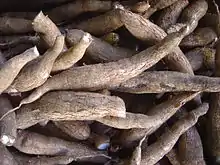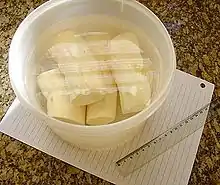Garri
In West Africa Garri is the powdery food material flour made from the tuberous roots of the cassava plant, which in the process of its manufacture is changed into dry edible granules.
.jpg.webp)


In the Hausa language, such powdery granules are also obtained from the processing of other crops, for example: garin dawa (guinea corn flour), garin masara (maize flour), and garin sukkhari (sugar), and particularly fried tapioca.[1] Garin magani is a powdery medicine.
Flour foodstuffs mixed with cold or boiled water are a major part of the diet amongst the various ethnicities of Nigeria, Benin Republic, Togo, Ghana, Guinea, Cameroon and Liberia.
Process
.jpg.webp)
To make garri flour, cassava tubers are peeled, washed and grated or crushed to produce a mash. The mash can be mixed with palm oil and placed in a porous bag, which is then placed in an adjustable press machine for 1–3 hours to remove excess water. Once dried it is then sieved and fried in a large clay frying pot with or without palm oil. The resulting dry granular garri can be stored for long periods. It may be pounded or ground to make a fine flour.[1]
Dishes
Eba is a stiff dough made by soaking garri in hot water and kneading it with a wooden baton until it becomes a smooth doughy staple. It is served as part of a meal with various soups and sauces. Some of these include okra soup, egusi soup, vegetable soup, afang soup, banga soup and bitter leaf soup.
Kokoro is a common Nigerian snack food, especially in southern and southeast Nigeria, especially Abia state, Rivers state, Anambra state, Enugu state and Imo state. It is made from a paste of maize flour, mixed with garri and sugar and deep-fried.[2]
Garri comes in various consistencies, which can roughly be categorized into rough, medium and smooth. Each type is used for a particular food.
As a snack, cereal, or light meal, garri can be soaked in cold water (in which case it settles to the bottom), mixed with sugar or honey, and sometimes roasted peanuts or groundnut with or evaporated milk are sometimes added. The amount of water needed for soaked garri is 3:1. Garri can also be eaten dry without water, but with sugar and roasted peanut added.

In its dry form, garri is used as an accompaniment for soft cooked beans and palm oil. This food mix is called yoo ke garri or Foto garri in the Ga language, in Ghana. Foto garri is the combination of moistened garri and stew, while yoo ke garri is garri with beans, a combination which is typically eaten as lunch.[1] It is also eaten with bean cake in Nigeria.
For a full meal, garri is usually cooked by adding it to hot water, then kneading it into dough. This is eaten with different types of thick, leafy vegetable stews, melon seed stews, peanut stews, or beans.
Smooth garri (known as lebu to the Yoruba) can be mixed with pepper and other spicy ingredients. A small amount of warm water and palm oil is added and mixed with the hand to soften up. This type of garri is served with fried fish. It is served with frejon on Good Friday.
Variations
In West Africa, the two types are white and yellow. Yellow garri is prepared by frying in palm oil; white garri is fried without palm oil.
Variations of yellow and white garri are common across Nigeria and Cameroon. One variation of white garri is popularly known as garri-Ijebu. This is produced mainly by the Yoruba people of Ijebu origin (Nigeria).
In Ghana, garri is judged by its taste and grain size. The sweeter types with finer grains are more valued over sourer, large grain varieties. Commercial food vendors prefer coarser grains with high starch content, as this yields more quantity when soaked in water.
Buyers often look out for crisper grains when trying to determine freshness.
Garri can be eaten without further cooking, as a snack, by placing it in a bowl and adding cold water, sugar, groundnut and milk. This is usually called garri soakings.[3] For example, ijebu-garri is made with finer grains, and has a pleasantly sour taste, making it very suitable to be eaten in this way. In most parts of West Africa, sugar or honey is then added as well as chunks of coconut, groundnuts, tiger nuts milk, and cashew nuts.
In most garri recipes it is cooked by adding boiling water and stirring to make a stiff paste or porridge. Eba is normally eaten with soups or stews. Most parts of Africa have an equivalent staple cassava dish.
In Liberia, garri is used to make a dessert called kanyan which is combined with peanuts and honey.
Nutritional benefit
Cassava, the root from which garri is produced, is rich in fiber, copper and magnesium.[4]
See also
References
- "Garri". African Foods. Retrieved August 6, 2015.
- "Snacks: Kokoro II". Dyfed Lloyd Evans. Retrieved 2009-11-09.
- Ofori-Mensah. "Recipe: Gari Soakings Deluxe". OMG Voice. OMG Voice. Retrieved 17 April 2018.
- "Nutritional benefit of 'Garri' and 'Fufu'". Food Doctors. Retrieved 29 June 2017.
External links
| Wikimedia Commons has media related to Garri (West Africa). |